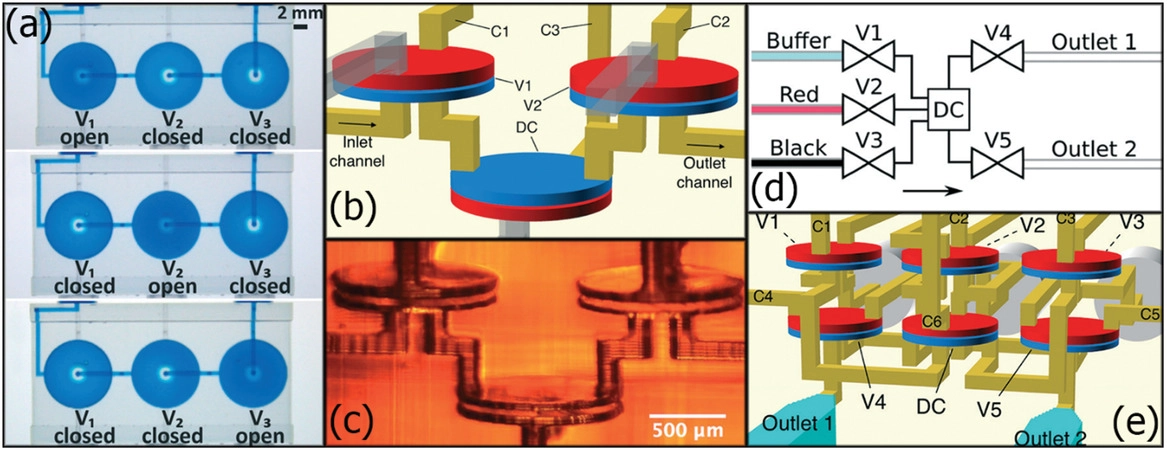European researchers have reviewed the 3D printing microfluidic applications in a study entitled, ‘Functional 3D Printing for Microfluidic Chips’.
The paper, published in Advanced Science, was written in light of recent advancements in 3D printed sensors, actuators, and other valuable elements for microfluidic devices, which has caused the field to switch over from traditional manufacturing methods like replica molding.
Microfluidics is useful in that it allows for the downscaling of biochemical applications from a lab setting to a portable format. According to the researchers, 3D printing can enable a new generation of microfluidic devices superior to those made with traditional methods:
“It is predicted that the widespread adoption of 3D printing in microfluidics will ultimately allow the creation of a new generation of increasingly smart, responsive, and autonomous devices, able to sense and act upon their environment in complex ways and with reduced human intervention.”

3D printing microfluidic chips, sensors, pipes and valves
Microfluidics, which involves the precise routing and manipulation of small fluidic streams to miniaturized laboratories, rely on microfluidic chips. Often made for specific applications, microfluidic chips are complex devices that are intended to provide a fast assessment and low consumption of both reagents and samples. Their small size makes them an attractive option for both laboratory environments as well as point‐of‐care (POC) settings.
The paper notes that 3D printing has been employed in the fabrication of microfluidic chips over the last few years. One reason for the widespread adoption of the technology is because 3D printing reduces the turnaround time from concept to reality for microfluidic chips. Typical 3D printing technologies used to create microfluidic chips include SLA, FDM, and multijet modeling (MJM).
However, the researchers claim that the benefits of 3D printing over traditional fabrication methods becomes clear when used to create chips with functional operators, such as actuators and sensors:
“The recent switch to direct printing of elements comes with unprecedented advantages for the design of elements, as modular designs of valves and pumps can be reused in digital drawings. At the same time, the process of device development is sped up, as 3D printing allows for the fast testing, adaption, and rapid prototyping of various designs.”
“3D printing technologies in the field of microfluidics is undeniable”
The study goes on to detail the different actuators and sensors that have been 3D printed within microfluidic devices. For example, the writers state that a valve has been fabricated using multi-material 3D printing, whereas traditionally they are only produced using a single material. By combining a flexible material and a stiff material, the valve differed in channel width, membrane thickness, and membrane material stiffness. On the other hand, pump designs that are 3D printed provide a fluidic flow resembling a syringe pump, helping to eliminate the need for hardware and increasing the accessibility of microfluidics.
Focusing on sensors, the authors of the paper explain that only a few have been 3D printed. Sensors in microfluidics help the liquid streams detect environmental changes, and react to external and internal stimuli. One example that the researchers provide is the bioprinting of cells for sensory information. They explain how an FDM 3D printer was used to create a monitoring device for water quality. As the device was printing, an anode, a cathode, and a proton exchange membrane were manually inserted, allowing the device to generate a signal by cultivating electrochemically active bacteria at the anode.
The paper concludes with the researchers considering the limitless applications of 3D printing for microfluidics: “The present and future impact of 3D printing technologies in the field of microfluidics is undeniable. By inheriting the intrinsic characteristics of 3D printing, microfluidic device development has become itself limitless, regarding factors such as the architecture, size, and number of devices produced.
“All of this can be presently achieved by 3D printing and its highly automated manufacturing process which allows for an equally limitless degree of reproducibility and customizability on the fly.”

Other microfluidic applications of 3D printing
As the paper details, 3D printing has been implemented within various microfluidic applications and has made various advancements over the years.
Earlier in August 2019, the Singapore University of Technology and Design‘s (SUTD) Soft Fluidics Lab developed a simple method to 3D print microfluidic devices integrated with fluid handling and functional components.
In March 2018, researchers from New York Genome Center (NYGC) and New York University (NYU) created an open-source, bedside 3D printed droplet microfluidic control instrument. The device represents a cheap, accessible method for identifying and targeting the correct cells to treat diseases like Rheumatoid Arthritis (RA).
‘Functional 3D Printing for Microfluidic Chips’ is co-authored by Gregor Weisgrab, Aleksandr Ovsianikov and Pedro F. Costa.
Subscribe to the 3D Printing Industry newsletter for the latest news in additive manufacturing. You can also stay connected by following us on Twitter and liking us on Facebook.
Looking for a career in additive manufacturing? Visit 3D Printing Jobs for a selection of roles in the industry.
Featured image shows manually controlled valves. Image via Functional 3D Printing for Microfluidic Chips.

